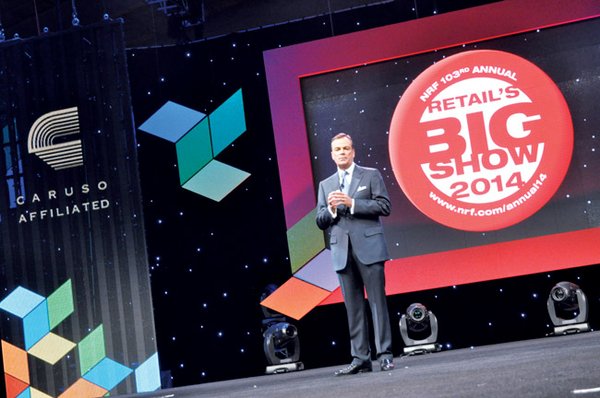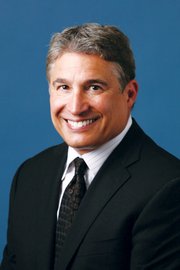RETAIL
End of the Mall? Retail And Real Estate Experts Weigh In on the Future of the Shopping Center
The traditional mall is losing relevance. It might already be a dinosaur.
Making the provocative statements was Rick Caruso of Caruso Affiliated, who popularized mixed-use, lifestyle-center malls such as The Grove in Los Angeles and The Americana at Brand in Glendale, Calif. His comments were made last month as part of the National Retail Federation’s 2014 Big Show keynote address.
“I’ve come to the conclusion that within 10 to 15 years, the typical U.S. mall, unless completely reinvented, will be seen as a historical anachronism that no longer meets the needs of the public, retailers or communities,” Caruso told the crowd of retail executives. “I believe the rebirth of retail will come as developers, retailers and cities understand the retail paradigm of the future is based on something timeless and enduring. People want to engage and feel a sense of community. They are driven by the experience.”
Caruso’s bombshell comments were accompanied by uncomfortable news for mall operators. ShopperTrak, a market-research firm that measures foot traffic in malls, found that consumer foot traffic plummeted 14.6 percent during the 2013 Christmas retail season despite a 2.7 percent increase in retail sales across several channels. The statistic suggested that while those shopping at malls made more purchases, many more were shopping at home through e-commerce.
California Apparel News spoke with a group of analysts, retailers and real estate players to gauge the state of the mall. While all agreed that the “A”-level mall will continue to thrive, the majority of speakers agreed with Caruso that the business will have to change.
The panelists included Fraser Ross, founder of the Kitson chain of boutiques, which has opened—and closed—locations in some of the most exclusive malls, including the Beverly Center in Los Angeles and The Americana at Brand, as well as in hip retail streets and more-unconventional locations such as airports.
Paco Underhill is an environmental psychologist who studies what makes people shop. As founder of market-research company Envirosell, and as author of books such as “Call of the Mall: The Geography of Shopping,” published in 2004, he has long analyzed what attracts and repels people from malls.
Giorgio Borruso is the owner of architecture firm Giorgio Borruso Design. He has built stores in malls such as South Coast Plaza in Costa Mesa, Calif.,and Americana at Brand and is the winner of international architecture awards, including the 2013 German Design Prize, the American Architecture Award (2010 and 2007) and the Retail Design Institute’s Store of the Year Award (2004, 2005, 2006, 2007, 2009 and 2010).
Jay Luchs is an executive vice president in the West Los Angeles office of Newmark Grubb Knight Frank and has brokered deals on top retail streets such as Rodeo Drive and Abbot Kinney Boulevard. He is a partner in the Malibu Village retail center in Malibu, Calif.
Larry Kosmont is president and chief executive officer of the Kosmont Companies, specializing in economic development, real estate and public finance. He consults with cities on public and private deals with retailers and mall developers. In 2009, Kosmont created the Kosmont Muni Horizons Fund, which sources private financing for public projects, government programs, infrastructure funding and economic development. He is a managing partner of the Renaissance Community Fund, which invests and develops mixed-use, residential and commercial projects throughout California.
Do malls need to change? How do they need to change?
FRASER ROSS: Malls are not bringing in freshness. You have got to provide more activities, fashion shows and celebrity signings so more people will have a reason to go. They have to be more experiential. Malls need to do a better job of integrating entertainment and dining. The cookie-cutter model is gone.
There are so many things that [mall operators] can do to keep people in malls, but [they] don’t do them. There should be stroller-rental services. You have to create a fun experience for kids in the mall—a kids’ store, a kids’ play area and a toy store. If kids visit the mall and have a great time, they’ll keep asking their parents to bring them back. Happy children equal a happy family. You need coffee shops and theaters. You don’t need another mass chain store in a mall. ... Malls are not looking at longevity, they’re just looking to get the highest rent.
I don’t see a great future for malls that open more stores for publicly traded companies that open their stores to satisfy their investors. In the long term, those stores won’t bring in much money. A lot of branded stores say, “Let’s open our own store and get double margin,” but you’re not getting the same sales. [Shoppers] come out of the store with one small bag—not 20 pieces. People want to diversify their wardrobes. A lot of people don’t know how to diversify stores quickly, and the market changes quickly. One minute, scarves are popular. The next minute, headbands are popular. In a boutique, you have the ability to be much more agile and to respond quickly to changes in taste.
It’s multi-brand stores that bring people to malls. We bring convenience shopping to the shopper. Stores also have to become mini department stores. That’s how you’re going to survive. You edit the best of the best collections. You have a beautiful cashmere sweater and a funny pillow next to it. You have every different price point.
If you don’t have a large, national bookseller in the mall, Kitson can bring people to the mall to buy books. We sold $3 million in books last year in minimal square footage due to the editing and attitude of the selection we provide.
Another point for consumers is that parking is important. [Malls] are overcharging for parking. That is one of the consumers’ biggest issues. Why do people have to pay for parking when they can have merchandise delivered to their home, no questions asked, no hassle?
What does Kitson look for in mall space?
FRASER ROSS: We need to be in a high-traffic lifestyle center with great dining, retail and movies and a mixture of international tourists and local clients. It is critical to us that the management team of the center be willing to partner with us on aggressively marketing our business and giving us the flexibility to do what we need to in order to be successful. For instance, if we are next to a theater or dining venue that attracts late traffic, we want the flexibility to stay open later. We expect that the center will commit to employing all available resources, signage, events, social and traditional media, to benefit us and, in turn, themselves.
Are malls in crisis?
PACO UNDERHILL: The cutting edge of the modern mall left North America long ago. Every developer outside the U.S. has been developing “alls” rather than “malls.” Think about Tokyo Midtown, Time Warner Center in New York and Darling Harbour in Sydney. In those places there is commercial shopping. There are offices, hotels and residential space. The mall itself offers a complete shopping solution—there are grocery stores, hardware stores, a place to arrange travel, a childcare facility. Look at Westfield properties outside of the United States. There has been an effort to bring a cross-section of tenants and improve the relevance of the shopping malls.
Clearly, for U.S. malls, the most underdeveloped asset is the asphalt that surrounds them. Many U.S. malls are crying out for redevelopment. Most U.S. malls have no connection to public transportation. Japanese malls are on top of railroad stations.
What do malls need to do?
PACO UNDERHILL: In the short term and the long term, they have to bring in a broader tenant mix. They have got to get over the paranoia of the shopping cart. The have to bring in grocery stores. They will have to bring in tenants that don’t necessarily pay high rent but tenants that bring in high foot traffic.
They also have to think about land. They have to think about better ways to utilize asphalt. “B” and “C” malls might build housing for the generation of baby boomers who don’t want to mow lawns. Many “A” locations are going to be fine. We don’t have the sophistication to meet [consumers’] desires. For example, in Korean subway stations, there are virtual stores, [e-commerce stores where consumers view walls lined with pictures of consumer products, make a purchase with their phones and have the products delivered to an address of their choice.] What if you went to Dodger Stadium and there were a series of tents where you could look at something?
What are malls doing right? Why do people need malls?
JAY LUCHS: [Retailers] can do high sales volume because there is a lot of foot traffic. People want to browse and shop, and malls are great places to do it. You go to malls to do the sales. A lot of brands go to streets for the image. But streets only have so much space. Malls have a lot of space.
Tenants want to be on [retail] streets because they are more eclectic. They go to places where they have great flooring and brick walls. For hip brands, image is everything to them. It is why streets are very important. Tenants’ images are created on the street. It is hard to create an image in the mall when all of the spaces look the same. I’m a fan of both [malls and retail streets].
You’ve made a career advising cities on retail. What are you telling them now?
LARRY KOSMONT: Cities are still starved for taxes and jobs, but we’ve seen huge turnover in retailers. The old days are over when retail centers were built and populated with big boxes. A lot of big boxes went dark, and a lot, like Best Buy, are going to a smaller footprint.
[Cities] need to attract tenants and retail projects that merge the bricks and clicks, bringing jobs and vitality that will last. If they do not focus on this, they are risking hard-earned public monies unnecessarily.
What do malls need to do?
LARRY KOSMONT: You’re going to see multi-faceted businesses with medical, education and housing. The retail center is going back to the old days. It is going to be about the village center and market squares. The key is to focus on infill sites and rethinking civic uses. The Internet is accelerating this trend.
Retail has become more about showmanship, events and entertainment value. Overall, we’re thinking that the way retail centers will change, a lot will have to be more trip-based.They’ll have to think about what people will make a trip for and what gets them out of the house more consistently.
What do malls need? Do they need more green space? More buildings that would evoke a sense of wonder?
GIORGIO BORRUSO: To be relevant today, the belief of maximizing dollars per square foot with schemes of recurring banality, based on simple grids and repetition, all masked by efficiency, needs to be replaced by a sense of discovery, variety and a willingness to sacrifice potential sales floor square footage in favor of enrichment of “public spaces,” such as gardens, fountains and playgrounds.
In terms of architectural language, it is fundamental to introduce variety, embracing a holistic approach that transcends the “shop–plus–food court” model, favoring a non-linear, complex center of different activities that mimics the intermix of uses of an urban environment, a “surrogate city,” combining leisure, gathering spaces, eateries and high-level entertainment and incorporating the use of natural elements, flora and water. Articulation between open exterior spaces and covered areas, interspersed with shopping, can be a model for the future metropolis.
I am not sure that architects need to “reinvent” the mall at all. As Rick Caruso astutely pointed out, describing people of the Paleolithic era sitting around the fire, humans have a natural desire—in fact, almost a biological need—to congregate, exchange stories, laugh, linger. My suggestion is to look at extraordinarily successful examples in our distant past—from Trajan’s Market [in Ancient Rome] to the ancient streets and piazze, integral components of the texture of the built city. These places were vital points of social gathering, the very lifeblood of the city, where people couldn’t wait to spend time, interact, be seen, learn, work, play and shop.
Maybe, with an eye to those utopic models, the mall could be a place that recognizes you—not just salutes or sells you, [is] able to understand your needs and aspirations, ambitions and even frustrations, the same way a good friend would do, thus providing temporary “warmth” and a sense of belonging that will brace you to return to the complicated life we all live.


























